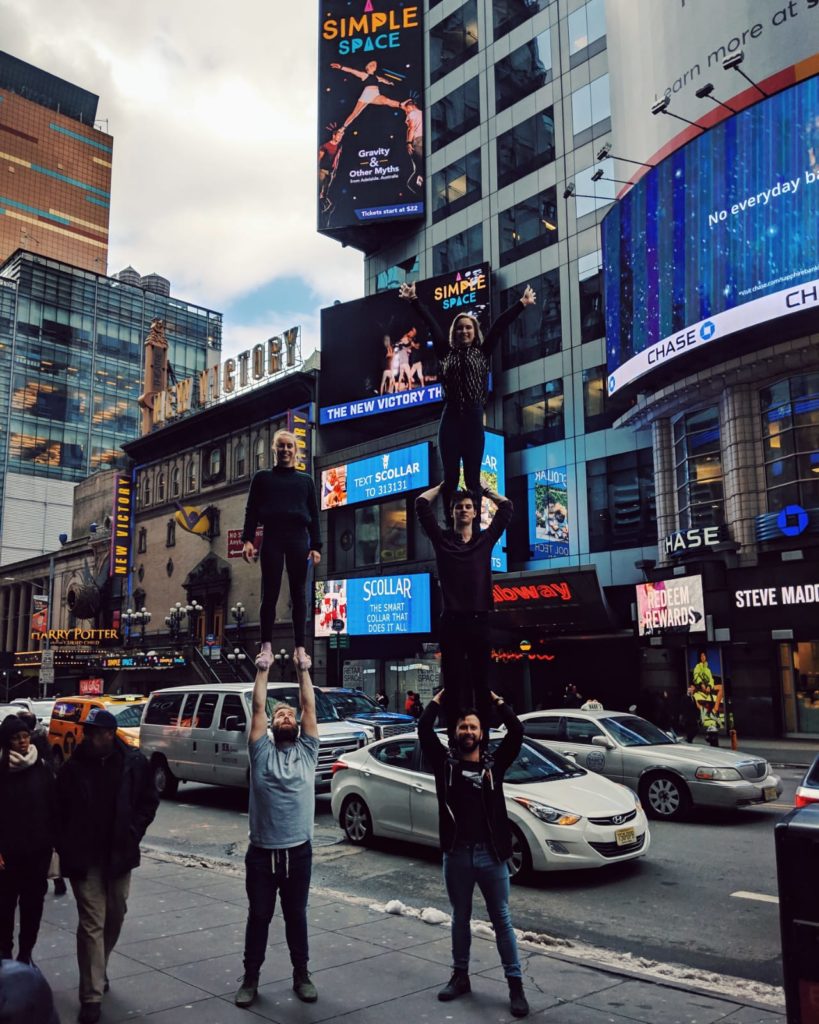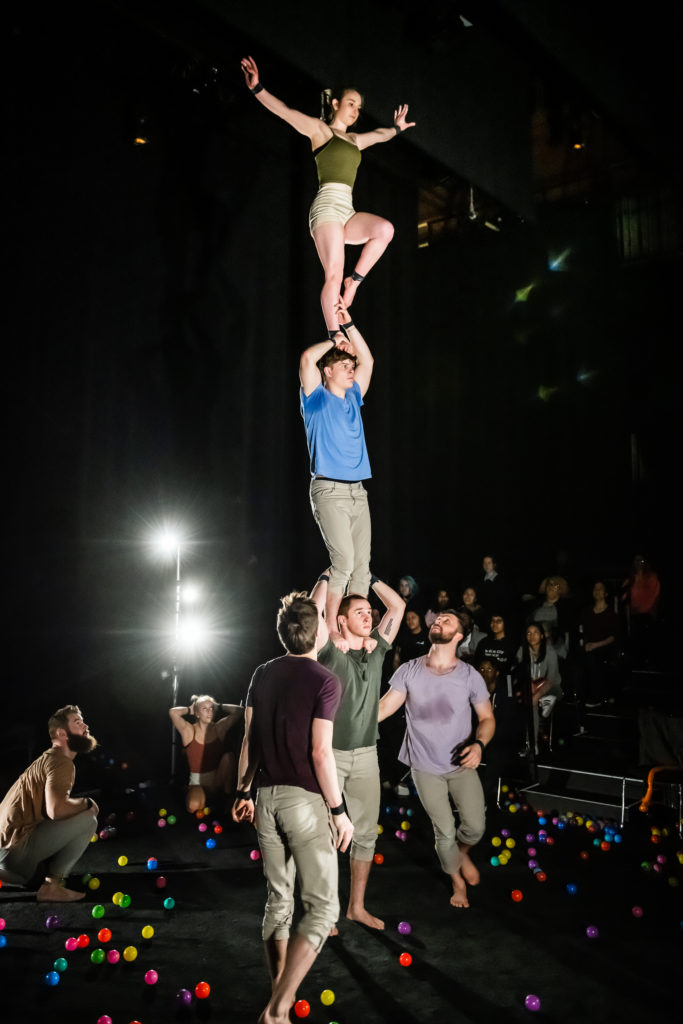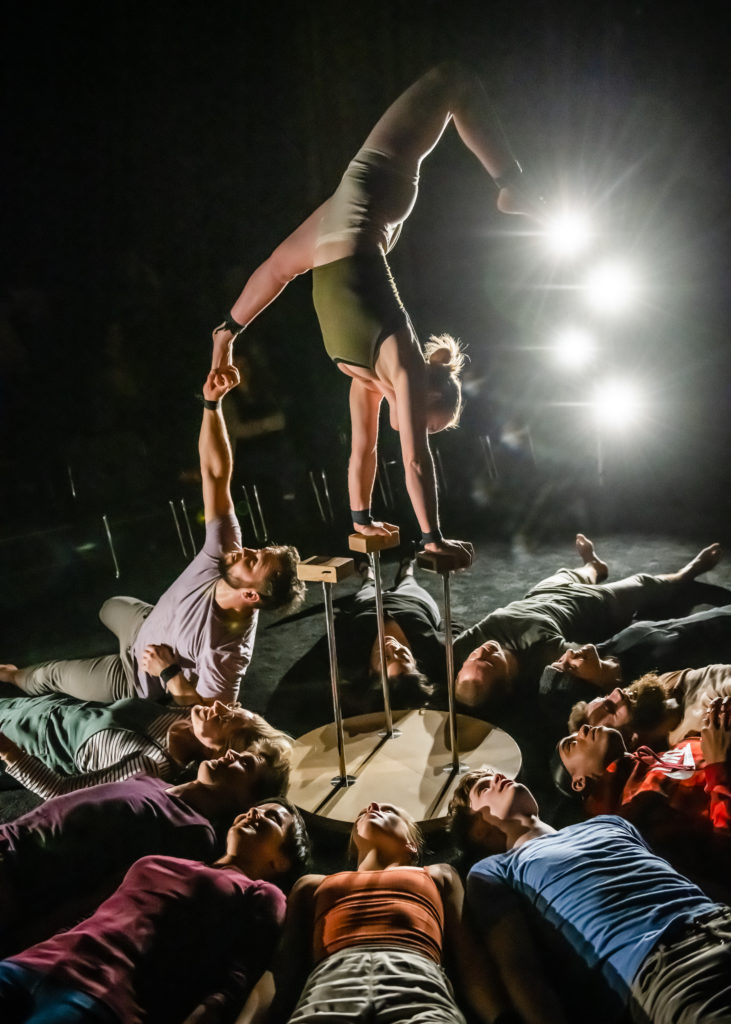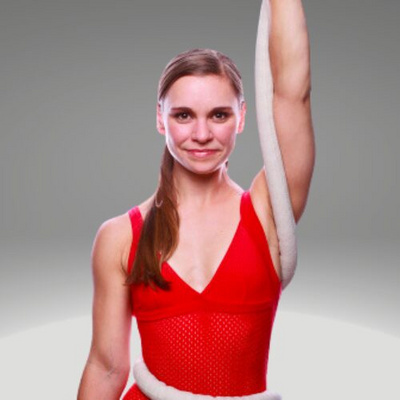Brains, Heart and Space for the Simple: a Conversation with Gravity and Other Myths

“Bigger is better” is a long time American circus tagline. It needs no interpretation. Adhering to this slogan, one would think that success for a touring circus company means more shows, more teams on the road, more countries visited to make more money. It’s a formula that smells of corporate conquests.
From the outside, Gravity and Other Myths fits the bill. In a quick decade they have gone from classmates at CirKids training center in Adelaide, Australia to being on the brink of sending their third full cast on a world tour. Rather than itching to conquer the contemporary circus scene, the enthusiastic cast members of Gravity and Other Myths (GOM) have nothing but gratitude and awe (backed by a lot of hard work) for their rapid growth. The company is thrilled to be making their New York City debut with the award winningA Simple Spaceplaying at The New Victory Theater. I had a delightful discussion with cast members Jake Randell, Elliot Zoerner and Ashleigh Pearce following the performance.

Our conversation hop-scotched from practical advice to memorable moments from the road, but it consistently jumped back to how invested GOM is in community engagement and company culture. Even my question about how the group stays healthy on the road was immediately met with recollections of cast members caring for each other, sharing knowledge and keeping the collective energy high.
Randell explained, “One of the founding members is a physio [physiotherapist / physical therapist]. He was on the road with us, and he was basically always giving us little lessons.” That knowledge has been instrumental to the troupe. Randell continued, “As for the quirky stuff, melatonin tablets for long haul flights. Getting over jet lag is so crucial because that’s the kind of stuff that’ll just knock you around. There’s an ongoing debate in the company, ‘What would you prefer, a long haul flight or a triple show day?’ I’d still prefer a triple show day.”
A Simple Space includes many good natured competitive moments (the most backflips, the longest handstand) peppered in amongst impressive, high energy group acrobatics. While these feats of three highs and toe hangs may seem foreign to the average New Yorker, the stripped down aesthetics of the show is inviting. The small playing space gives an intimate, studio feeling. The minimalist set steers full focus to the cast. ‘Welcome to our world’, the show says, and then the audience is actually asked to join the action.
Zoerner, the show’s musician, employs a call and response technique to involve the crowd during an impressive percussion solo using nothing but his own body to create a plethora of tones and rhythms. Cast members hand out colored balls that the audience throws at the cast while they are trying to sustain a handstand. In my favorite moment, audience members lay in a circle under Pearce as she executes a lovely hand balancing routine. This simple construction did two things. First, we were invited to imagine what it might be like to view the act from below – a refreshing perspective. Secondly, it preserved the simple joy of circus without trying to make it something else. This was a constant theme inA Simple Space: how the simple develops into the complex. I found myself thinking, who makes space for the simple anymore?
Through these choreographic choices, the audience got to have an intimate experience with the cast throughout the production. I asked if there was anything that would surprise the audience to know about GOM’s off-stage life.
Pearce explained, “From the outside it might look a bit spontaneous and chaotic, our lives, but I think the element that would surprise people is that you are able to establish a bit of a routine within the chaos of traveling.” She described how the cast finds a rhythm with each other and these patterns start to synch up. “We find a flow within the chaos.”
This was a constant theme in A Simple Space: how the simple develops into the complex. I found myself thinking, who makes space for the simple anymore?

That flow is a necessary ingredient to keeping spirits high. Zoerner spoke about the importance of the cast warming up as a group before each show. He readily considers which songs to add to a playlist or a game that will get everyone moving. These deliberations are key, he says to “keeping the group really tight.” This close knit work environment is no accident. GOM sprouted from a group of friends with similar drive and ideals, and they continue to hire performers that compliment the group’s dynamic.
Zoerner explained that, “the aim is really to hire the right people that are going to fit with our company culture and that want to push themselves for the next few years as well.”
I asked what young artists need to cultivate to become the right kind of person for the job. The answer: The Hustle.
Randell defined what that means for GOM. “On our manifesto we have a few things — shoulder to shoulder, commitment to chemistry, sweat and joy — three of our outlines for our company culture. And the hustle is a big thing. When you’re hiring someone you look at their technical skills. What you don’t see in a video is what we call the hustle. And everyone knows what hustling is: getting it done. For us, that has been such a big thing for our company. To go, all right, it’s not working, do we just give up or do you hustle it? How do you push through, and push through and push through?”
For Zoerner, “The best things is a team of people you have on tour that want to get there an hour early to do extra training.”
The smallest of contributions to ensure the show is the best it can be go a long way for the company culture. Things like asking the technicians for a vacuum if the carpet on stage is looking ‘a bit bad’ might seem like going above and beyond the job description of an acrobat, are actually the standard for a GOM member. It’s those qualities, Jake mentioned, that don’t come through in an audition video. GOM invites potential cast members into the studio to train with them when considering a new hire.
This part of the conversation felt timely. I recently reviewed an art’s related panel where I was left feeling disheartened. The purely digitalized way live performers are asked to market themselves expunges key in-person elements such as professional etiquette, know-how and collaboration skills from the hiring process.
GOM’s hiring process, directly correlates to the on-stage energy. The cast is alway ready with a high five, a pat on the back or a look of ‘well done’ for their peer’s accomplishments. This in turn feeds the quality of the work. A dynamic ending of the playful acrobatic skill Double Dutch in which the flyers are passed from base to base, exemplifies an expertise which can only be achieved with trust and communication. The show exemplifies the need for young performers not only to develop their technical skills, but to also cultivate collaboration, professionalism and the hustle.
I asked, how do you learn the hustle? As we mused about how a young person becomes instilled with these traits, it became evident that the answer is built into GOM’s company practices. Recognizing the help and support they had along the way which attributed to their successes, they have established the Seedling Fund.

“The Seedling Fund is a chunk of money we put away at the beginning,” Randell explained. He reminisced, “We came through CirKids, and when you’re starting, when you’re sixteen, seventeen you have no money.” A $300 fee to enter a festival seemed impossible at that age for the original GOM members. The Seedling Fund is meant to be a revolving pocket of money to ease that financial burden. “The idea was for people to take it, register for [Adelaide] Fringe, buy a few props, do the show, get their money back, put it back in there and…the next generation uses it…Risk free, basically, just to help that emerging artist form something or try an idea. Because too often there’s too many good ideas, and there’s just no one backing them at the beginning. We had good people that supported us and we want to give that back.”
We had come full circle. The camaraderie evident inA Simple Space is no accident. Not only is it fostered within the company, but The Seedling Fund is a concrete way that GOM shares its values. I was curious what the company might have said to their younger selves now that they are in the role of mentoring upcoming artists and companies.
Randell laughed at this, “I just wouldn’t have believed anything I said! Just go with the journey. The thing that I always look back on is that I am so glad that I took that risk…and with great risk can come great reward.” He spoke of the company’s beginnings, “We all had heart in the right place, brain in the right place and werevery lucky as well. The right people were around us to support us.” Now, he considers he’s “won the lottery. I love what I do with people I love, and for me, that is just the most amazing thing.”
No whiffs of corporate conquest here. Brains, heart, support and luck have taken GOM around the world. Just as The Seedling Fund is designed to reproduce a bit of that magical recipe in Australia, GOM enjoys fostering relationships wherever they perform. They even extended an invitation to the Circus Talk community.
“If you like our work, definitely come and see us, and introduce yourself afterwards or send us an email with what you’re doing. We love hearing from people and getting in touch with the circus community,” Zoener said. “So hit us up. We want to hang out, we want to train, go get food, get a beer. We want to have the good times with the circus community. It’s a bloody good one. We’re pretty lucky to be part of it.”
When the cast isn’t battling jet lag, training together or building community they have their own ways to relax.
Elliot explained, “It’s not always the rockstar life of going out to bars after the show….we have to stay healthy, so often it’s video games,” “We do love our Mario Kart,” Jake added, “Board games,” Ashleigh threw in, “And a curry!” Elliot said. Jake summed it up, “We’re pretty normal people when it comes down to it.”
Normal people that took a risk, stayed committed, hustled and are now living a life they love.
To catch Gravity and Other Myths in action you don’t have to go too far from home. Their touring schedule spans the globe. A Simple Space, Backbone, and their latest production Out of Chaos, are all slated for European tours for the summer months.
Feature photo courtesy of New Victory Theater. Photo credit: Maike Schulz.
Editor's Note: At StageLync, an international platform for the performing arts, we celebrate the diversity of our writers' backgrounds. We recognize and support their choice to use either American or British English in their articles, respecting their individual preferences and origins. This policy allows us to embrace a wide range of linguistic expressions, enriching our content and reflecting the global nature of our community.
🎧 Join us on the StageLync Podcast for inspiring stories from the world of performing arts! Tune in to hear from the creative minds who bring magic to life, both onstage and behind the scenes. 🎙️ 👉 Listen now!
